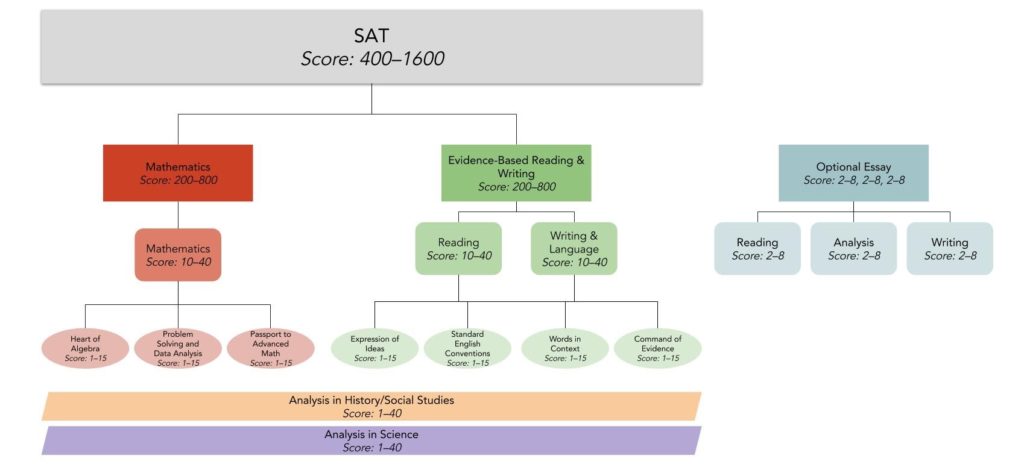SAT Score Range: How to Break Down Your Score

If the SAT score scale confuses you, don’t worry—you are not alone. At a high-level, your SAT score is on a scale of 400-1600. However, the College Board includes a lot of numbers on your score report in an attempt to accurately capture your performance in as many knowledge areas as possible. In this post, we identify each score scale presented on an SAT score report and discuss how you should interpret them.
What Is the Middle 50% Score Range for Colleges?
Colleges want qualified students to apply, and one way they signal who is competitive is by posting an Academic Profile of the most recently accepted first-year students on the admissions website. Here are a couple examples from Boston University and the University of California, Los Angeles.
As part of the Academic Profile for recently accepted first-year students, schools often include a range of SAT scores for students who achieved the middle 50% of scores. There will always be some students with uncharacteristically low SAT scores that the school admits due to the other strengths of their profile. By contrast, some accepted students have scores much higher than their peers. In making the middle 50% of SAT scores public, schools offer new applicants a rough sense of how competitive they will be while still leaving room for scores above and below their stated SAT range.
You can use these middle 50% of SAT scores to gauge how competitive your application would be at any number of colleges and universities. Let’s use Boston University as our example.
| BU’s middle 50% of SAT Scores | Score range for BU as a safety school | Score range for BU as a target school | Score range for BU as a reach school |
| 1420-1530 | 1530 or higher | 1480–1520 | 1420–1470 |
Its accepted students’ middle 50% of SAT scores were 1420–1530. To have BU as a reach school, you should aim for a score within the middle 50% of SAT scores. For BU, that would mean scoring above a 1420. If you do not fit within that range, you certainly should still apply! In fact, 25% of admitted students gained acceptance with scores lower than the published range. Simply acknowledge going in that other aspects of your application must be exceptional in order for you to be offered admission.
If you want to situate BU as your target school, aim for the upper half of the published score range. In the case of BU, the middle of 1420–1530 is 1475, so round up to 1480. A student who wanted to make BU their target school would look at those numbers and say, “Alright, I want an SAT score of at least 1480, ideally something a little higher.”
For safety schools, your SAT score should be at or above the highest score in the range. You should not call BU a safety school unless your SAT score is at or above 1530.
To review….
| A school is likely a safety if… | A school is likely a target if… | A school is likely a reach if… |
| your SAT score is at the 75th percentile of admitted student scores or higher. | your SAT score is in the top 50% of admitted student scores. | your SAT score is in the bottom 50% of admitted student scores. |
Build your SAT score goal off three or four Academic Profiles for what you hope will be target schools. Of that initial list of desired target schools, select the one with the highest SAT score range, then aim for the score that would put your SAT in the upper half of scores for accepted students at that school.
What Is the SAT Scoring Scale?
The overall SAT is scored on a scale of 400–1600. You may be wondering why scores are given on this scale. After all, you did not have to answer 1600 questions, so where does the number 1600 come from? Some versions of the SAT are slightly harder than others. It would be unfair for students who happened to sit for the test on a more difficult day to receive lower scores. For that reason, the College Board does not focus on raw scores—the number of questions each student got correct.
Instead, the College Board scales raw scores to fit a normal distribution curve. For every test, the same percentage of 1600s, 1500s, etc. are given as compared with all previous tests. The 1600 scale is purposefully arbitrary—it would be impossible to confuse a scaled score out of 1600 with a raw score out of 154 (the number of questions on an SAT).
But wait—you may say—what about all these other numbers on my score report? Once we get away from the overall score out of 1600, understanding SAT score scales gets a bit tricky. Here’s a chart where you can follow along as we break down each score in detail.

The Mathematics Section is based on a scale of 200–800. This score is added to your Evidence-Based Reading and Writing score to get your overall SAT score.
The Evidence-Based Reading & Writing (EBRW) Section uses that same 200–800 scale.
The two EBRW Subsections are Reading and Writing & Language. These are each scored on a scale of 1–40. To get your total EBRW score, simply add your two subsection scores together and multiply by ten.
Mathematics has a Subsection, also called Mathematics. This is scored on a 10–40 scale as well, essentially so that there is symmetry between the two major sections of the SAT.
All other subscores have no impact on your overall SAT score of 1600. These other scores simply exist to highlight your academic strengths and weaknesses.
The optional Essay Section is a three-number score, and each of those numbers falls in the 2–8 range. For example, the lowest Essay score is a 2–2–2, while the highest possible score is an 8–8–8.
The optional Essay Subsections are Reading, Analysis, and Writing. Two readers grade your response on a 1–4 point scale in these three categories. Their grades are then added to give you Reading, Analysis, and Writing subscores in the 2–8 range. The overall Essay Section score is a list of your three subscores in that same order: Reading, Analysis, and Writing.
Additional subscores are awarded by concept area. Throughout the test, questions in each section are tagged as being related to certain concept areas. Your raw score of the total number of questions you get right for each concept is converted to a scaled score in the 1–15 range.
In Mathematics, the concept areas are Heart of Algebra, Problem Solving and Data Analysis, and Passport to Advanced Math.
In EBRW, the concept areas are Expression of Ideas, Standard of English Conventions, Words in Context, and Command of Evidence.
Cross-section scores are awarded by subject area. On the SAT, questions in Mathematics and EBRW are tagged whenever they also assess another key subject area, such as history or science. Your raw score on these subject area questions is scaled to 1–40.
Analysis in History/Social Studies is one of the cross-section subject areas.
Analysis in Science is the other cross-section subject area.
In addition to all these section, subsection, concept area, and cross-sectional scores, the SAT offers percentile rankings. Your percentile ranking for each category reveals how you performed relative to your peers. For every one hundred students who take the SAT, “X” students scored lower than you, with “X” being your percentile ranking.
How to Understand Your SAT Score
While the SAT scoring system is complicated, each section and subsection gives you valuable information on where your knowledge stands in relation to that of your peers. Your section scores in Math, EBRW (Verbal), and the optional Essay can answer your big picture question, “Am I performing at the level where I want to be?”
To give a low-end baseline, by the time you apply to college, you will want to clear the College Board’s college readiness benchmarks. The College Board states that students who score at or above 530 in Mathematics are ready to move onto college. For Verbal, it believes that students who receive a 480 or higher are prepared to continue their education. At a minimum, competitive college applicants should aim to clear these college readiness benchmarks.
Additionally, for your overall SAT score, you’ll want to score as high as you can in each section, ideally with a balanced score. Aim to bring your Math and Verbal score within 50 points of each other. To put it in other words, if you think you can achieve a 700 in Math, you want to receive at least a 650 in the Verbal section.
If you want to improve one of these section scores, take a look at your subsection, concept area, and cross-section scores. These numbers will give you a sense of how to customize your test preparation to build your weaknesses into strengths.
Look for low scores to identify weaknesses. Is your Writing & Language score ten points lower than your Reading score? Then invest more time in that area. Is your “Passport to Advanced Math” score a 5, while your other two concept areas in Math are double digits? Consider reviewing questions that lay the foundation for Advanced Math. Is your Analysis in Science score half the value of your Analysis in History/Social Studies score? If so, devote additional time and attention to SAT passages that focus on scientific study.
Additionally for the optional Essay section, aim for a score that roughly aligns with your overall SAT score. Try to match the percentile of your overall SAT with the percentile ranking of your Essay score in each subsection.
| Subsection Score | Reading | Analysis | Writing |
| 8 | 99 | 99+ | 98 |
| 7 | 96 | 99 | 93 |
| 6 | 70 | 93 | 53 |
| 5 | 48 | 79 | 33 |
| 4 | 18 | 51 | 9 |
| 3 | 8 | 32 | 4 |
| 2 | 0 | 0 | 0 |
Source: College Board and CollegeVine data analysis
How Do I Set My SAT Score Goal?
To thrive with your college applications, you should aim for a score that is as high as possible and as balanced as you can make it. To review, here are the questions to ask yourself as you set an SAT score goal:
-
Have I cleared the College Board’s college readiness benchmarks?
- For Math, this means scoring above a 530.
- For Verbal, your score should exceed 480.
- Is my Math score within 50 points of my Verbal score?
- Am I in the top 50% of scorers for my most competitive target school?
If you see your score faltering in certain areas, take advantage of the many concept and subject break-downs provided in your SAT score report as you prepare for your next test date.
At the end of the day, remember that your SAT is only one part of the bigger picture. Do your best to earn a score that reflects your potential. At the same time, remember that your SAT score is merely one star in the constellation of factors that make you stand out in the admissions process.
Want to know how your SAT score impacts your chances of acceptance to your dream schools? Our free Chancing Engine will not only help you predict your odds, but also let you know how you stack up against other applicants, and which aspects of your profile to improve. Sign up for your free CollegeVine account today to gain access to our Chancing Engine and get a jumpstart on your college strategy!


